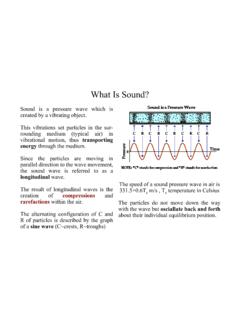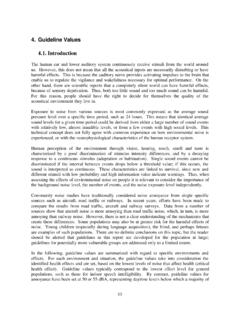Transcription of f Spectral Analysis – Fourier Decomposition
1 Spectral Analysis Fourier Decomposition Adding together different sine waves PHY103 image from f Spectral Decomposition Fourier Decomposition Previous lectures we focused on a single sine wave. With an amplitude and a frequency Basic Spectral unit ---- How do we take a complex signal and describe its frequency mix? We can take any function of time and describe it as a sum of sine waves each with different amplitudes and frequencies Sine waves one amplitude/ one frequency Sounds as a series of pressure or motion variations in air. Sounds as a sum of different amplitude signals each with a different frequency. Waveform vs Spectral view in Audition Clarinet spectrum Clarinet spectrum with only the lowest harmonic remaining Time ! Frequency! Spectral view Waveform view Full sound Only lowest harmonic Four complex tones in which all partials have been removed by filtering (Butler Example ) One is a French horn, one is a violin, one is a pure sine, one is a piano (but out of order) It s hard to identify the instruments.
2 However clues remain (attack, vibrato, decay) Making a triangle wave with a sum of harmonics. Adding in higher frequencies makes the triangle tips sharper and sharper. From Berg and Stork Sum of waves Complex wave forms can be reproduced with a sum of different amplitude sine waves Any waveform can be turned into a sum of different amplitude sine waves Fourier Decomposition - Fourier series What does a triangle wave sound like compared to the square wave and pure sine wave? (Done in lab and previously in class) Function generators often carry sine, triangle and square waves (and often sawtooths too) If we keep the frequency the same the pitch of these three sounds is the same. However they sound different. Timbre --- that character of the note that enables us to identify different instruments from their sound . Timbre is related to the frequency spectrum.
3 Square wave Same harmonics however the higher order harmonics are stronger. Square wave sounds shriller than the triangle which sounds shriller than the sine wave From Berg and Stork Which frequencies are added together? To get a triangle or square wave we only add sine waves that fit exactly in one period. They cross zero at the beginning and end of the interval. These are harmonics. f frequency 5f 3f Periodic Waves Both the triangle and square wave cross zero at the beginning and end of the interval. We can repeat the signal Is Periodic Periodic waves can be decomposed into a sum of harmonics or sine waves with frequencies that are multiples of the biggest one that fits in the interval. Sum of harmonics Also known as the Fourier series Is a sum of sine and cosine waves which have frequencies f, 2f, 3f, 4f, 5f, .. Any periodic wave can be decomposed in a Fourier series Building a sawtooth by waves Cookdemo7 a.
4 Top down b. bottom up Light spectrum Image from ~ sound spectrum f 3f 5f 7f frequency amplitude Time Sharp bends imply high frequencies Leaving out the high frequency components smoothes the curves Low pass filter removes high frequencies Makes the sound less shrill or bright Sampling If sampled every period then the entire wave is lost The shorter the sampling spacing, the better the wave is measured --- more high frequency information More on sampling Two sample rates A. Low sample rate that distorts the original sound wave. B. High sample rate that perfectly reproduces the original sound wave. Image from Adobe Audition Help. Guideline for sampling rate Turning a sound wave into digital data: you must measure the voltage (pressure) as a function of time. But at what times? Sampling rate (in seconds) should be a few times faster than the period (in seconds) of the fastest frequency you would like to be able to measure To capture the sharp bends in the signal you need short sampling spacing What is the relation between frequency and period?
5 Guideline for choosing a digital sampling rate Sampling rate should be a few times shorter than 1/(maximum frequency) you would like to measure For example. If you want to measure up to 10k Hz. The period of this is 1/104 seconds or You would want to sample at a rate a few times less than this or at ~ Period is 1/frequency Recording in Audition The most common sample rates for digital audio editing are as follows: 11,025 Hz Poor AM Radio Quality/Speech (low-end multimedia) 22,050 Hz Near FM Radio Quality (high-end multimedia) 32,000 Hz Better than FM Radio Quality (standard broadcast rate) 44,100 Hz CD Quality 48,000 Hz DAT Quality 96,000 Hz DVD Quality Demo degrading sampling and resolution Clip of song by Lynda Williams sampling is 48kHz resolution 16 bit 48kHz sampling , 8 bit 11kHz sampling, 16bit Bits of measurement 8 bit binary number 00000000b = 0d 00000001b = 1d 00000010b = 2d 00000011b = 3d 00000100b = 4d.
6 11111111b = 511d can describe 2^8 = 512 different levels Bit of precision Error in amplitude of signal loudness error error in recording the strength of signal sampling Bits of measurement A signal that goes between 0 Volt and 1 Volt 8 bits of information You can measure 1V/512 = = 2mV accuracy 16bits of information 2^16 = 65536 1V/65536= = = 15micro Volt accuracy Creating a triangle wave with Matlab using a Fourier series dt = ; % sampling time = 0: ; % from 0 to seconds total with sampling interval dt % Here my sample interval is or a frequency of 10^4Hz frequency1 = ; % This should be the note A % harmonics of this odd ones only frequency2 = frequency1* ; frequency3 = frequency1* ; frequency4 = frequency1* ; % here are some amplitudes a1 = ; a2 = ; a3 = ; a4 = ; % here are some sine waves y1 = sin( *pi*frequency1*time); y2 = sin( *pi*frequency2*time); y3 = sin( *pi*frequency3*time); y4 = sin( *pi*frequency4*time); % now let's add some together y = a1*y1 - a2*y2 + a3*y3 - a4*y4; plot(time, y); % plot it out Playing the sound %Modify the file so the second line has time = 0:dt:2; %(2 seconds) %Last line: play it: sound (y, 1/dt) Save it as a.
7 Wav file for later wavwrite( *y,1/dt,' ') Phase Up to this point we have only discussed amplitude and frequency x = 0:pi/100:2*pi; y = sin(x); y2 = sin( ); y3 = sin( ); plot(x,y,x,y2,x,y3) Sine wave period amplitude phase What happens if we vary the phase of the components we used to make the triangle wave? y1 = sin( *pi*frequency1*time); y2 = sin( *pi*frequency2*time - ); y3 = sin( *pi*frequency3*time - ); y4 = sin( *pi*frequency4*time + ); y = a1*y1 + a2*y2 + a3*y3 + a4*y4; Shape of wave is changed even though frequency spectrum is the same Is there a difference in the sound ? These two are sums with the same amplitude sine waves components, however the phases of the sine waves differ. Another example This sound file has varying phases of its frequencies. Do we hear any difference in time? sound file from Spectrum of this sound Waveform views at different times Do we hear phase?
8 Helmholtz and Ohm argued that our ear and brain are only sensitive to the frequencies of sounds. Timbre is a result of frequency mix. There are exceptions to this ( , low frequencies) Two major psycho-acoustic models 1) Place theory each spot in basal membrane is sensitive to a different frequency 2) Timing rate of firing of neurons is important and gives us phase information What is the role of each in how our ear and brains process information? Open questions remain on this. Cutting and pasting audio High frequencies introduced Sharp changes in wave form Phase shift Demo with a cut and paste in Audition/Audacity of a generated sine. Note: the effect in Spectral view depends on the length of the FFT used, also you need to be fairly zoomed out horizontal to see the noise. Transform and inverse transform f 3f 5f 7f frequency amplitude Time I have shown how to go this way How we will talk about how to take a signal and estimate the strength of its frequency components Multiplying two cosines with different frequencies Multiplying two cosines with the same frequency The average is not zero.
9 The average is 1/2 Multiplying two cosines with different frequencies What if your window fits here? Windowing and errors Calculating the amplitude of each Fourier component What is the average of Over a long interval this averages to zero unless f=g Sine/Cosine functions are orthogonal Calculating the amplitude of each Fourier component Procedure: multiply the waveform f(t) by a cosine or sine and take the average. Multiply by 2. This gives you the coefficient Am or Bm. Predicting the spectrum of a plucked string Can one predict the amplitude of each mode (overtone/harmonic?) following plucking? Which pluck will contain only odd harmonics? Which pluck has stronger higher harmonics? Odd vs Even Harmonics and Symmetry Sines are Anti-symmetric about mid-point If you mirror around the middle you get the same shape but upside down More on Symmetry Sines are anti-symmetric Cosines are symmetric Symmetry Additional symmetry of odd sines if you consider reflection at the black line.
10 About this line, Odd harmonics are symmetric but even ones are anti-symmetric n=1 odd n=3 odd n=2 even Symmetry of the triangle wave Obeys same symmetry as the odd harmonics so cannot contain even harmonic components Odd Fourier components Both triangle waves and square waves contain odd Fourier components. f 3f 5f 7f frequency amplitude Sawtooth What overtones are present in this wave? Use its symmetry to guess the answer. Spectrum of sawtooth All integer harmonics are present. The additional symmetry about the wave that both triangle and square wave have is not present in the sawtooth. Generated tones Order of 440Hz tones: Sine, Triangle, Sawtooth, Square, Rectangular with 10%/90% Sawtooth Triangle Symmetry as a compositional element From Larry Solomon s Symmetry as a compositional element -- last phrase of Bartok s Music for Strings, Percussion and Celesta, movement I Reflection symmetry in tones --- axis of symmetry is an A microcosmos vol 6 141 Free variations Reflection in time Axis of symmetry is a time (Example from Larry Solomon) Anton Webern, Opus 27 Predicting the spectrum of a plucked string Can one predict the amplitude of each mode (overtone/harmonic?)







